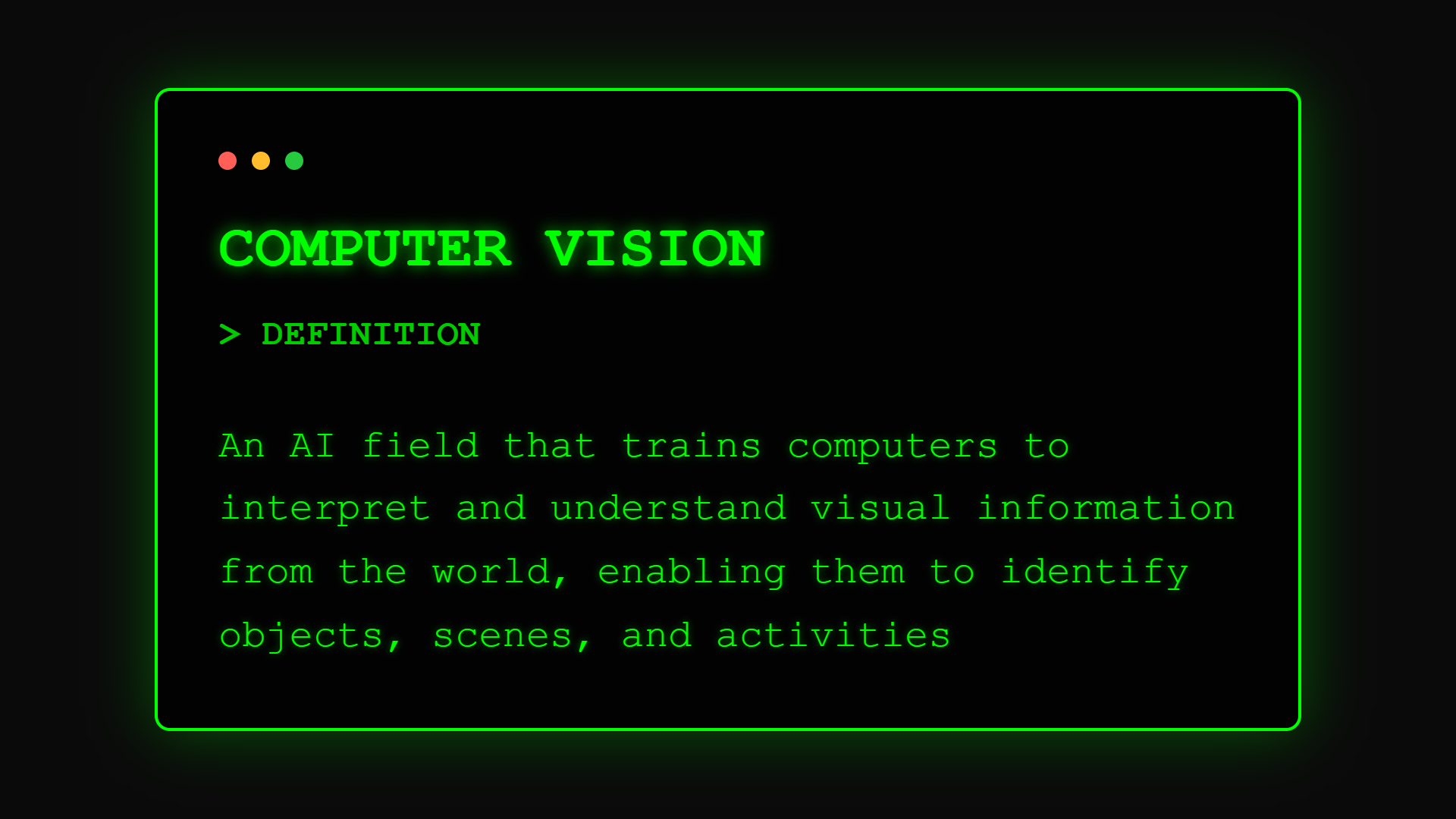AI Terms
What is Computer Vision? Giving Your Business Digital Eyes

A quality inspector can check 100 products per hour. A computer vision system can inspect 10,000 with greater accuracy, never getting tired or distracted. This technology isn't just about cameras and sensors. It's about teaching machines to understand what they see and make intelligent decisions based on visual information.
Historical Background
Computer vision originated in the 1960s when researchers first attempted to mimic human visual perception. The field began with the ambitious goal described by MIT's Seymour Papert in 1966 to solve vision in a summer project. It took 50 years instead.
According to the IEEE Computer Society, computer vision is "an interdisciplinary field that deals with how computers can gain high-level understanding from digital images or videos, seeking to automate tasks that the human visual system can do."
The field evolved from simple edge detection in the 1970s to modern deep learning approaches that can outperform humans in specific visual tasks. The breakthrough came with convolutional neural networks in 2012, which revolutionized image recognition accuracy.
Business Applications Explained
For business leaders, computer vision means giving machines the ability to see, understand, and make decisions based on visual information, automating any task that requires human eyes and judgment.
Think of computer vision as hiring a visual expert who never blinks, can watch thousands of locations simultaneously, and improves their expertise with every image analyzed. It transforms cameras from passive recording devices into active business intelligence systems.
In practical terms, this means automated quality control that catches defects humans miss, security systems that recognize threats instantly, and retail analytics that understand customer behavior from video.
Critical Components
Computer vision consists of these essential elements:
• Image Acquisition: Cameras and sensors that capture visual data, from simple webcams to specialized industrial cameras, thermal sensors, or 3D scanners
• Pre-processing Engine: Systems that enhance and standardize images by adjusting lighting, removing noise, correcting distortions to ensure consistent analysis
• Feature Detection: Algorithms that identify important visual elements: edges, corners, textures, shapes, and colors that distinguish objects
• Pattern Recognition: Neural networks that match detected features to learned patterns, recognizing that specific shapes and colors represent a defective product
• Decision Layer: Logic that translates visual understanding into business actions by triggering alerts, controlling machinery, or updating databases
The Vision Process
The computer vision process follows these steps:
Image Capture & Digitization: Cameras convert light into digital data as millions of pixels, each with color and brightness values, creating a numerical representation
Analysis & Feature Extraction: Algorithms scan pixel patterns to identify meaningful features by detecting edges where colors change, recognizing shapes, finding text or faces
Interpretation & Action: The system compares detected features against trained models to understand what it sees, then triggers appropriate responses
This transforms raw visual data into business intelligence: from "array of pixels" to "defective product on Line 3" to "stop conveyor and alert supervisor."
Four Main Categories
Computer vision generally falls into four main categories:
Type 1: Object Detection & Recognition Best for: Inventory management, security screening, product identification Key feature: Identifies and locates specific objects in images Example: Amazon Go stores tracking products customers select
Type 2: Image Classification Best for: Quality control, medical diagnosis, document processing Key feature: Categorizes entire images into predefined classes Example: Sorting products as "pass" or "fail" on assembly lines
Type 3: Motion Analysis Best for: Security monitoring, traffic management, sports analytics Key feature: Tracks movement and analyzes behavior patterns Example: Retail stores analyzing customer flow to optimize layouts
Type 4: 3D Reconstruction Best for: Manufacturing inspection, augmented reality, construction Key feature: Creates three-dimensional models from 2D images Example: Creating digital twins of physical products for analysis
Computer Vision at Work
Here's how businesses actually use computer vision:
Manufacturing Example: BMW's quality control system inspects painted car bodies using computer vision, detecting defects invisible to human eyes with 99.7% accuracy while reducing inspection time by 30%.
Retail Example: Walmart uses computer vision to monitor shelf stock levels across 4,700 stores, automatically alerting staff to restock items and reducing out-of-stocks by 30%.
Healthcare Example: Google's diabetic retinopathy detection system analyzes eye scans with 90% accuracy, screening thousands of patients daily in areas with limited access to specialists.
Further Learning
Ready to implement computer vision in your business?
- Understand the foundation with Artificial Intelligence
- Explore Deep Learning that powers modern vision systems
- Learn about Edge Computing for real-time visual processing
- Start with our Computer Vision Implementation Guide
FAQ Section
Frequently Asked Questions about Computer Vision
Part of the [AI Terms Collection]. Last updated: 2025-01-10